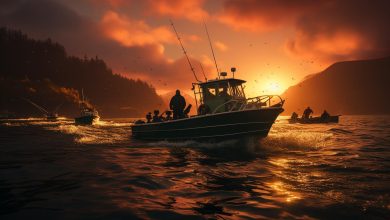Saltwater Fly Fishing Essential Gear And Techniques For The Ocean
You stand at the edge of the ocean, watching waves crash against the shore. The sun is just starting to rise, casting a warm glow on the water. You take a deep breath of salty air and feel excitement building within you.
Today, you are going saltwater fly fishing.
Saltwater fly fishing may seem daunting at first, but with the right gear and techniques, it can be an incredibly rewarding experience. From selecting the appropriate rod and reel to mastering different casting methods, there are many elements that go into successful saltwater fly fishing.
In this article, we’ll guide you through everything you need to know to get started on your own saltwater fly fishing adventures.
So grab your gear and let’s dive in!
Choosing the Right Rod and Reel
You’ll want to make sure you’ve got the perfect set-up if you’re serious about catching those big ones out there. Choosing the right rod and reel is essential in saltwater fly fishing. It’s important to find a balance between the two that will allow you to cast accurately, handle strong fish, and enjoy your time on the water.
When customizing your setup, consider the type of fishing you plan on doing and the species of fish you hope to catch. A longer rod may be necessary for casting distance, while a shorter one may provide more accuracy in tight spaces. You’ll also want to choose a reel with enough drag to handle larger fish and withstand saltwater corrosion. Ultimately, your goal is to have a setup that feels comfortable in your hands and can handle any challenges thrown its way.
Now let’s move onto selecting the appropriate fly line for your next trip on the water.
Selecting the Appropriate Fly Line
When it comes to choosing the right line for your next saltwater fly fishing trip, there are a few factors you should consider. Firstly, you’ll need to think about the type of fly line that will best suit your needs.
There are three main types of fly line: floating, sinking and intermediate. Floating lines work well for topwater presentations such as poppers or dry flies, while sinking lines are better suited for fishing deep water or heavy currents. Intermediate lines offer a happy medium between the two and can be used in shallow or moderate depths.
Factors affecting fly line choice include the species of fish you’re targeting, water conditions, and weather patterns. For example, if you’re after bonefish in shallow flats with clear water, a floating line may be your best bet to avoid spooking the fish. On the other hand, if you’re fishing for tarpon in deeper waters with strong currents, a sinking line will help get your fly down to where the fish are feeding.
By considering these factors and doing some research on specific brands and models of fly lines available on the market today, you’ll be able to make an informed decision that will help increase your chances of success.
Selecting the appropriate fly line is just one piece of gear that’s essential for successful saltwater fly fishing trips out on the ocean. Once you’ve made your choice on which type of line will work best for your needs based on factors like water conditions or target species, it’s time to move onto picking leaders and tippets – another critical aspect of any angler’s gear setup when heading out onto saltwater environments!
Picking Leaders and Tippets
Now it’s time to delve into selecting the right leaders and tippets to complete your setup for a successful day on the water. Leaders are typically made of monofilament or fluorocarbon, while tippets are usually lighter and thinner versions of the leader material. The length and thickness of both leaders and tippets depend on the size of fly you plan to use, as well as the species of fish you’re targeting.
Here are three key things to keep in mind when picking out leaders and tippets:
-
Knot Strength: It’s crucial to tie strong knots when attaching your leader to your fly line, as well as when connecting your leader to your tippet and fly. Weak knots can cause frustrating break-offs during casting or fighting a fish.
-
Matching Tippet Size: As mentioned before, tippets are usually thinner than leaders, but they still need to be matched appropriately in size with the type of leader material you’re using. This ensures that there is a smooth transition from thicker leader down to thinner tippet, preventing any hiccups during casting or presentation.
-
Adjusting Drag: When tying on your fly, make sure that it moves freely without any snags or resistance from the hook eye rubbing against the knot where the leader meets the eyelet. Additionally, adjusting drag according to what species you’re fishing for will help prevent broken lines upon hookset.
With these tips in mind, you’ll be able to choose appropriate leaders and tippets for a variety of saltwater fishing situations. Next up: using the right flies!
Using the Right Flies
Choosing the proper fly can make all the difference in hooking that trophy fish and feeling the rush of a thrilling catch. When it comes to saltwater fly fishing, there are a plethora of different flies to choose from, each with their own unique attributes and purposes. Fly selection is not only about choosing the right color or size but also about understanding how your presentation skills affect the way a fish responds to your fly.
To help you understand which fly to use in which situation, we have created a table below outlining some popular saltwater flies and their recommended usage:
| Fly Name | Recommended Use |
|---|---|
| Clouser Minnow | All-purpose baitfish imitation |
| Puglisi Peanut Butter | Great for imitating crabs or shrimp |
| Deceiver | Good for larger gamefish like Stripers or Tarpon |
| Gurgler | Surface popper used for topwater action |
Using the right fly is just one part of successful saltwater fly fishing, though. Mastering techniques such as casting into wind and working your retrieve can be just as important. In the next section, we will cover these essential techniques so you can become an expert angler on the ocean waters.
Mastering Techniques for Saltwater Fly Fishing
When it comes to saltwater fly fishing, you need to be prepared for any conditions the ocean throws your way. You’ll need to master three key techniques: casting in windy conditions, retrieving techniques, and handling big fish.
Don’t worry if you’re new to these techniques – with practice and persistence, you’ll soon become a pro at tackling even the toughest saltwater fly fishing challenges.
Casting in Windy Conditions
To truly master casting in windy conditions, you’ll need to adjust your technique and focus on timing and power. One way to combat wind drift is by double hauling, which involves pulling the line with both hands during the back cast and forward cast to increase speed and distance.
Additionally, using a heavier fly line can help cut through the wind and make it easier to cast. Timing is also crucial when casting in windy conditions. Wait for a lull in the wind before making your back cast, then use a quick, powerful forward cast to send the line out into the water.
Be sure not to overpower or rush your casts, as this can cause tangles or inaccurate casts. With practice, you’ll learn how much force is needed to effectively cast in varying levels of wind.
Now that you’ve mastered casting in windy conditions, it’s time to move onto retrieving techniques.
Retrieving Techniques
Now that you’ve mastered casting in windy conditions, it’s time to focus on your retrieving techniques. This is where the real magic happens, as you entice the fish to strike your fly with lifelike movements.
There are several methods of retrieving, but two popular ones are strip and twitch and popper and dropper.
The strip and twitch method involves pulling the line in short, sharp strips while simultaneously twitching the rod tip. This creates a jerky motion that mimics a wounded or fleeing prey. It’s an effective technique for imitating baitfish, shrimp, or crabs.
On the other hand, popper and dropper is a surface technique where you cast a floating popper fly with a trailing nymph or streamer called a dropper. The idea is to create commotion on the surface by popping the fly while also presenting a subsurface offering for more finicky fish.
With these techniques mastered, you’ll be ready to handle big fish like a pro!
Handling Big Fish
Once you’ve honed your skills in casting and retrieving, the next challenge is handling big fish, which requires finesse and patience.
When a large fish takes your fly, it’s important to keep calm and maintain steady pressure on the line. Avoid jerking or yanking the rod too hard as this could cause the hook to come loose or even break the line.
As you feel the weight of the fish on your line, use your rod and reel to guide it away from rocks or other dangerous areas. Keep your hands wet when handling the fish and avoid touching its gills or eyes.
If possible, keep the fish in the water while removing the hook and taking photos before releasing it back into its natural habitat. Remember that proper conservation practices are crucial for preserving our oceans’ ecosystems for future generations of anglers to enjoy.
Conclusion
Congratulations! You’re well on your way to becoming a saltwater fly fishing pro with the knowledge and gear you’ve acquired. Don’t be discouraged if you don’t catch anything right away, remember that practice makes perfect. Keep honing those techniques and experimenting with different flies until you find what works best for the particular fish species in your area.
As Hemingway once said, "The sea is the same as it has been since before men ever went on it in boats." But with your newfound expertise in saltwater fly fishing, you’ll be able to navigate these timeless waters with skill and confidence.
So, get out there and cast your line into the deep blue. Who knows what kind of treasures lie waiting beneath the surface?


